
| What is Flavor and Fortune? |
| How do I subscribe? |
| How do I get past issues? |
| How do I advertise? |
| How do I contact the editor? |
Read 13152133 times
Connect me to:
| Home |
| Articles |
| Book reviews |
| Letters to the Editor |
| Newmans News and Notes |
| Recipes |
| Restaurant reviews |
| Article Index (all years, slow) |
| List of Article Years |
| Article Index (2026) |
| Article Index (last 2 years) |
| Things others say |
| Related Links |
| Log In... |
| Authors |
| Categories & Topics |
TOPICS INCLUDE: Fortune cookies; Geckoes; Black forbidden rice; Food chains growing in China; Hollow corn bread
| by Jacqueline M. Newman |
Letters to the Editor
Winter Volume: 2008 Issue: 15(4) page(s): 6 and 7
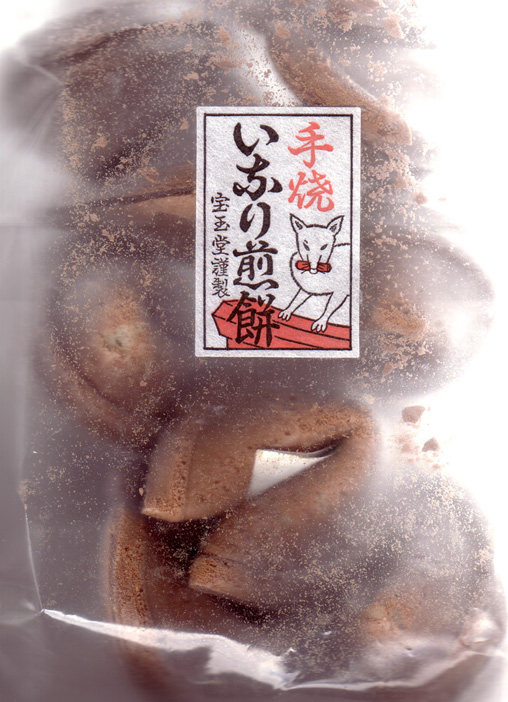 From HILLARY via e-mail:
From HILLARY via e-mail:
I liked knowing about fortune cookies in Japan. Do you know what their fortunes say? I once read about moon cake messages; any connections?
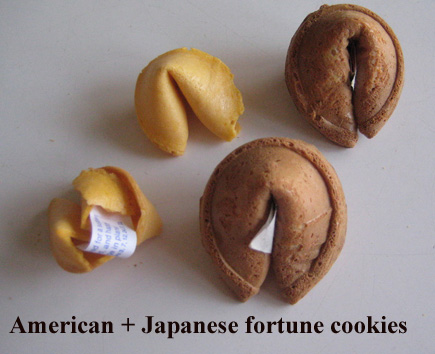 HILLARY In response to your first question, as I do not read Japanese had to ask Brett, the article's author.
HILLARY In response to your first question, as I do not read Japanese had to ask Brett, the article's author. 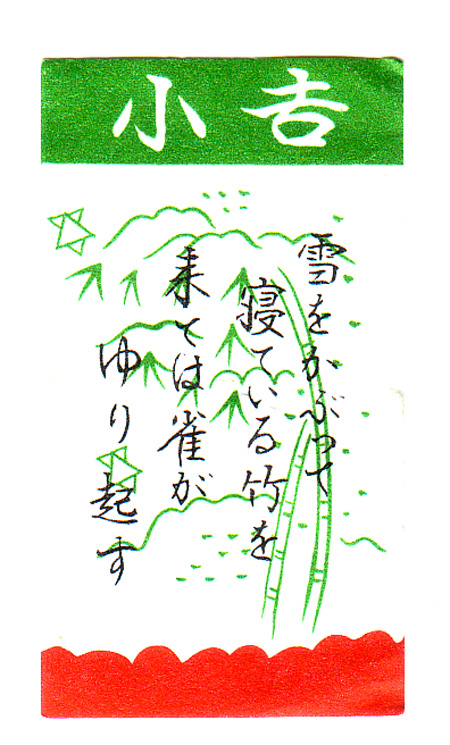 He advises the fortune's header, that is the green part of the message, says: Good luck. He tells us that not all headers are identical. Fortunes in the Japanese cookies he purchased are poems with seasonal meanings, a standard motif in Japanese fortune cookies. This is quite different from Chinese fortune cookies. The one photographed says: The sparrow stirs the bamboo sleeping with snow on its top. This message, he says, is supposed to evoke the season, which was Spring when he bought the cookies and thus the snow shaken off by the spring bird landing on the branch tells that this is between winter and spring. As to your second query, Tony Liu of Toro Associates, wrote in a brochure, distributed in New York City’s Chinatown, that the origin of fortune cookies can be traced to the 13th century when Chinese soldiers inserted rice-paper messages into moon cakes to help coordinate their defense against Mongolian invaders.
He advises the fortune's header, that is the green part of the message, says: Good luck. He tells us that not all headers are identical. Fortunes in the Japanese cookies he purchased are poems with seasonal meanings, a standard motif in Japanese fortune cookies. This is quite different from Chinese fortune cookies. The one photographed says: The sparrow stirs the bamboo sleeping with snow on its top. This message, he says, is supposed to evoke the season, which was Spring when he bought the cookies and thus the snow shaken off by the spring bird landing on the branch tells that this is between winter and spring. As to your second query, Tony Liu of Toro Associates, wrote in a brochure, distributed in New York City’s Chinatown, that the origin of fortune cookies can be traced to the 13th century when Chinese soldiers inserted rice-paper messages into moon cakes to help coordinate their defense against Mongolian invaders.
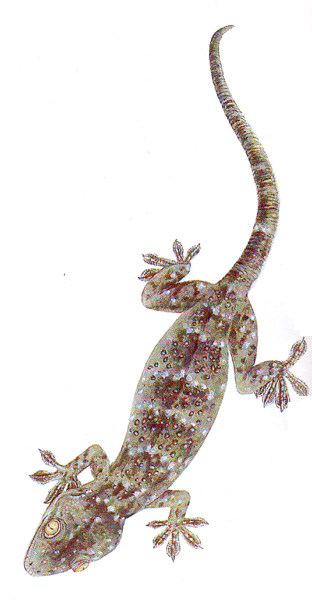
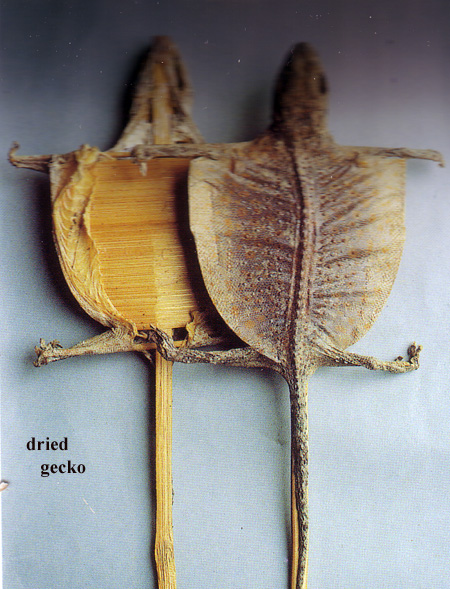 From PETI in PERU:
From PETI in PERU:
You have written about geckoes, but according to your index of recipes at your web site, I never saw a recipe for one (nor did I ever see one elsewhere). Do the Chinese really eat these critters, and if so, what do they look like and do you have such a recipe?
PETI: Yours was not an easy search, but it did bring one positive, a recipe for a pork soup. Be advised, we have never seen them live but have seen them in Chinese herbal stores. Also, we have never knowingly been served one nor eaten one; though when we see another dried one we will make the soup that appears below. The herb store we went to had none. That said, here are some pictures and after all letters, a recipe cut years ago from a Chinese/English magazine. The herbalist in that store told us a soup made with them relieves asthma, reduces coughs and is good for your qi. He also advises that he sometimes has dried ground gecko. When I asked how much of that equals one gecko, he showed with his hands what, to me, looked like a couple of tablespoons, and said when he gets more he'll figure out the volume.
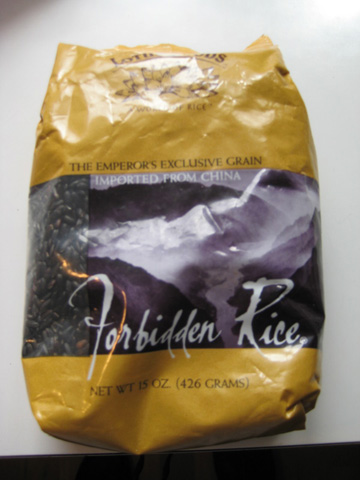
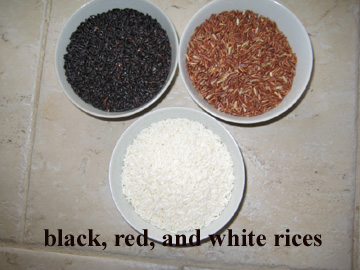 From MAIDA via e-mail:
From MAIDA via e-mail:
I hope you can answer my questions. The first is why do the Chinese cook their rice with no salt, the second is how long and how does one cook black rice; and a last question, I would appreciate anything you can share about black rice.
MAIDA Cooking rice, in general, for the Chinese means to cook all kinds of rice, no matter its color or kind, without any salt; no oil, either. Rice is served as the carrier or accompaniment for meats and vegetables made with sauce or salt or both, so there is no need for any. Also, black rice is also known as Forbidden rice. It is prepared a little differently from cooking white, or red, or glutinous rice, long or short grain. It is best not to use a rice cooker because it needs a different length of time and amount of water than does white rice. Before cooking, rinse the rice for about five minutes under running water until the water is almost clear. When cooking, use double the amount of water to rice, and after bringing the water to the boil, cover the pot, reduce the heat to a simmer, and cook it for thirty-five minutes. Next, remove the pot from the heat source and let it rest five or more minutes before peeking in. When you do, note that the rice is purplish-black. It looks lovely, particularly when served with Chinese greens. One can mix black rice with cooked white rice or serve it plain. The taste of the former is somewhat nutty, the texture a mite firm, and the color is most unusual. The picture is of black, red, and white rices.
From SUE via e-mail:
A friend told us that Pizza Hut and Kentucky Fried Chicken chains are growing like mad in China. Is this really true, and why?
SUE: These are tough questions, answers we do not have. But Sam Su, President of Yum! Brands, China Division did write that these places are #1 quick-service brands in China. Under the headline: Winning Big in China, he says there are more than two thousand five hundred restaurants in more than four hundred cities. They opened close to five hundred new ones in 2007, and same store sales are growing. Furthermore, as he looks into the future, he says they want to open more than twenty thousand restaurants; and ends saying "we are winning big in China and the best is yet to come." As to the why; you need to query him and his ordinary Chinese customers.
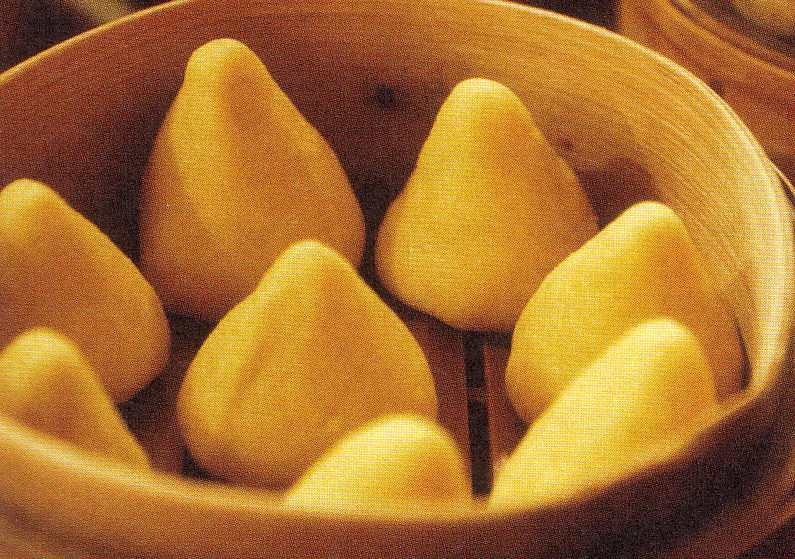 From LESTER via e-mail:
From LESTER via e-mail:
I once read about delicious sweet hollow corn bread served to Empress Cixi when she fled to Xian near the end of the Qing Dynasty. Can you tell me its ingredients and provide a recipe.
LESTER: The recipe I believe you are speaking about is really a Beijing speciality. It is shown in the volume titled: Beijing Local Delicacies that was reviewed in the 'On Our Bookshelves' set of pages beginning on page 20. That particular book has no recipes. The recipe below is a variation of one attributed to the Imperial kitchens of the Empress.
| Pork Soup with Dried Geckoes |
|---|
1/2 pound pork shin, with bone 2 Chinese brown dates 1 candied Chinese date 1 piece dried tangerine peel, soaked for one hour, then cut into small pieces 2 dried geckoes Preparation: 1. Blanch the pork in boiling water for two minutes, then drain and cut into several large pieces. 2. Put all ingredients into a clay pot, add two quarts of boiling and bring this almost to the boil. Reduce the heat and simmer for several hours until about one and a half cup of liquid remains. |
| Black Rice Dumplings |
|---|
1/2 pound glutinous black rice 1 and 1/2 cups chicken stock 3 slated duck eggs 1 Tablespoon white sesame seeds, toasted 1 Tablespoon minced purple laver (a seaweed sheet) 2 Tablespoons sugar 1 Tablespoon thin soy sauce 1 Tablespoon vegetable oil Preparation: 1. Prepare black rice as above using the chicken stock instead of water. 2. Steam or simmer the salted duck eggs for twelve minutes, cool slightly, then discard the shells and mince the eggs. 3. Mix minced laver, sugar, and the soy sauce, and set aside. Then mix rice, minced salted eggs, and the sesame seeds, and shape this rice mixture into twenty round balls. 4. Brush oil on a baking sheet, and put the black rice balls on it separating them by one-inch on all sides. Make a hole in each rice ball, and pour about one-quarter teaspoon of the laver, sugar, and soy sauce mixture into every one of them. 5. Bake in a 400 degree F preheated oven for eight minutes, then serve. |
| Hollow Corn Bread |
|---|
1 pound less two tablespoons yellow corn flour (not corn meal) 6 Tablespoons defatted yellow soybean flour 1/2 pound granulated sugar 1 Tablespoon osmanthus flower paste Preparation: 1. Mix corn and soybean flours with the sugar into a bowl and stir well. Make a well in this flour mixture. 2. Mix half cup and two tablespoons of warm water with the osmanthus flower paste, then pour into the flour and knead this into that mixture. 3. Roll the dough into two even cigar-shaped pieces one inch thick. Cut each of these into twenty to thirty pieces, then shape each piece of dough so the bottom is large and the top is pointed (see the picture). Insert a thumb in the bottom of each piece of dough making the bottom half of it hollow. 4. Steam over rapidly boiling water for twelve minutes, then serve warm. |

Copyright © 1994-2026 by ISACC, all rights reserved
Address
3 Jefferson Ferry Drive
S. Setauket NY 11720